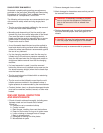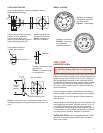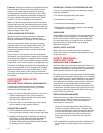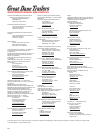E
xteriors: Cleaning the outside of refrigerated trailers
should be done the same way dry-freight vans are
cleaned. Live steam does a good job of cleaning
and brightening the exterior surfaces of van trailers.
Application of a protective transparent coating may
b
e used to protect the exterior surface from further
oxidation. Do not use brightener on the trailer.
Note: A trailer with open holes should not be steam
cleaned until the holes have been patched or panels
replaced. Allowing moisture or chemicals to enter the
walls or roof through holes may cause corrosion and
may add weight to the trailer.
CHECK INSULATION EFFICIENCY
Weigh the trailer at regular intervals to determine if
there is moisture accumulation or water pickup
through condensation or leakage into the insulation.
Check for spots where water may leak out during
cleaning, other than from regular drain holes. This
indicates water entrance into the insulation. The
areas allowing water to enter must be located and
properly sealed.
Keep a record of the length of time the mechanical
refrigeration unit cycles and its frequency. An increase,
of an appreciable degree, in frequency and in duration
of the cycles, or both, could indicate a general deterio-
ration either in the trailer insulation or refrigeration unit.
Excessive air leakage may cause the refrigeration unit
to run for long periods of time. Excessive air leakage
indicates problems such as perforated walls or worn
out areas of door seals or door locks around vents,
side doors, and refrigeration units. These areas should
be repaired.
MAINTAINING INSULATION
EFFICIENCY
MOISTURE PICKUP THROUGH CONDENSATION
If it has been determined that you have moisture
contamination in the insulation cavity, you should
take one of the following steps:
a. Open the doors of the trailer and park it in the sun.
It takes several days of hot, sunny weather to
equalize water vapors trapped in the trailer body
with that of the outside air, or;
b. Place the trailer in a controlled-heat, paint-drying
oven to speed up the process of drying.
RAIN WATER LEAKAGE
a. Check outside and inside of trailer for holes and
loose joint seams through which moisture may seep.
b. Waterproof all openings immediately by patching
and sealing, or both, especially after accidents in
which body and roof skin may have been cut.
Synthetic-rubber-base-type sealer should be used
for closing all minor openings.
E
XCESSIVE CYCLING OF REFRIGERATION UNIT
If the unit is operating properly, the excessive cycling
c
ould be caused by:
a. Air transfer through leaking door seals.
b. Deterioration of insulation.
c. Unusually hot surrounding temperature.
d. Refrigeration unit improperly sized for the intended
temperature for that cargo.
SUBFLOORS
Since subfloors are enclosed on the top side and open
at the bottom, they are subject to considerable road
splash and corrosion. Where they have deteriorated
to a point where they no longer function as effective
vapor barriers and water seals, they should be
repaired or replaced.
DOORS, VENTS, HATCHES
When seals are worn out they must be replaced.
Check and correct, as required, the alignment of door
hinges and locks.
SAFETY MEASURES —
URETHANE FOAM
URETHANE FOAM FLAMMABILITY
Urethane foam has achieved an extensive history in a
variety of applications, including insulation in refrigerat-
ed trailers, because the performance of urethane insu-
lation has been superior to other materials.
One area of concern is the fire potential and flammability
of urethane when exposed during repair of surrounding
areas. Urethane foam is combustible like cork, wood or
other organic materials. When urethane is exposed to
the intense heat of welding, flame cutting or other hot
work wherein a high-density heat source is used in
repairing an insulated trailer, certain precautions must
be observed. Urethane foam burns (including fire-retar-
dant types) producing toxic smoke which may or may
not be visible to personnel.
PRECAUTIONARY MEASURES
Clean the work area. Never allow urethane scrap
or other organic materials to be in the work area or
around the trailer. Do not allow foam material to
accumulate on the job site.
1. Under no circumstances shall a direct flame be
allowed to contact urethane foam. Urethane foam
must be mechanically cut away and totally removed
from around the repair area by at least two feet or
an obviously safe distance away to prevent any
flame from coming in contact with the urethane
materials.
2. All combustible materials below the workpiece must
be removed to prevent ignition from hot sparks or
slag.
24


















